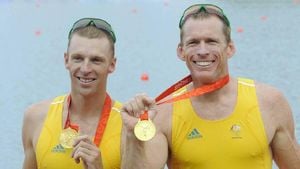Exercise has long been hailed as the cornerstone of good health, but new research is emphasizing even more dramatically its potential to extend life. Recent studies suggest just how significant physical activity can be for adding years to one's life. It’s intriguing to find out just how many lives could be saved and how many more years could be lived simply by embracing a lifestyle infused with movement.
According to findings released from a study published in the British Journal of Sports Medicine, engaging more frequently and effectively in physical activity substantially lowers the risks of mortality. Researchers from Griffith University led the analysis, which utilized accelerometry—technology used to monitor movement—to get precise data on physical activity levels across populations. Their work revealed some eye-opening results.
For adults older than 40, simply reaching the activity levels of the top 25% of ambulatory individuals could potentially add as many as five years to their lifespans! This suggests there's more to physical activity than mere fitness; it's about survival too. This finding directly positions exercise not just as part of fitness regimens but as pivotal to longevity.
Lead researcher Professor Lennert Veerman highlighted the dramatic differences between active and inactive populations. Individuals who are the most active experience a staggering 73% lower risk of death compared to their less active counterparts. Who would have thought? The study revealed startling statistics: increasing physical activity levels could extend lifespan by up to 11 years for the least active individuals! What’s more, even taking just one hour of brisk walking could add around six hours to one’s life.
“If you’re already very active or within the top quartile, adding more activity might not be as impactful as it would be for those on the lower end of activity,” remarked Veerman. The challenge lies not just with existing fitness enthusiasts, but rather with the couch potatoes of our society. The least active quarter of the population stands to reap the highest rewards by simply moving more.
This is not just about adding years to your life; it's about adding life to your years. Exercise helps reduce the risk of various diseases, including obesity, stroke, diabetes, and heart disease. Activity levels tend to act as protective factors against certain cancers as well.
Professor Veerman likens the positive effects of physical activity to those of smoking cessation, asserting the ramifications of being sedentary can be as dire as the consequences of heavy smoking. Every cigarette smoked could shave approximately 11 minutes off your lifespan, illustrating the life-or-death importance of staying active.
When you think about it, shifting toward more physically conducive environments could be transformative. Veerman suggests enhancing the design of parks, creating neighborhoods perfect for walking, and making public transportation both convenient and accessible could lead to longer lives overall. “Physical activity can halve your risk of death. Why not invest more heavily both financially and socially to encourage exercise?” asks Veerman. Indeed, there’s evidence backing the claim: time and again, research ties exercise to remarkable health benefits, from boosting brain health to improving mood and enhancing sleep quality.
This study does not just end with the statistics; it draws messages about social behavior and health. According to Robert Graham, associate director at the Scripps Gerontology Center at Miami University, there is much to be done to extend life expectancy across American populations, including focusing on health disparities dictated by socio-economic conditions. For example, inequalities arise from geographic positions and seasonal climate changes, leading to varying access to health facilities which are often reflected in overall health and longevity.
Graham explains, “The way life expectancy is viewed and experienced greatly varies from one county to the next. The approach needs to be nuanced and adapted to local needs,” he adds. For now, Ohio itself serves as the focal point of study due to recent discussions about its declining life expectancy metrics. Vinton County has the lowest life expectancy at around 69.9 years, compared to Delaware County at 81.3 years, which possesses the highest. The differences can largely be attributed to local health resources and the social determinants of health, such as economic stability and accessibility to nutritious food and healthcare services.
Dr. Nanette Lacuesta from OhioHealth puts forth the notion of recognizing factors such as income, education, transportation, and food security as components influencing health. “If you can't get to the food store or you’re stuck at home with no transport, how can you eat healthily?” she questions. Not to mention the burden of isolation, which can degrade life quality and health status. Loneliness has been termed 'the new smoking,' and with equal veracity, the need to nurture community connections is pronounced.
Discussing unique solutions for improving life expectancy is necessary, as is recognizing the pivotal role of diet quality. Dr. Jennifer Middleton emphasizes the importance of nutrition by advocating for high-fiber foods, fresh produce, and reduced sugar consumption. “To genuinely empower individuals, it’s about providing them with the knowledge of attainable choices,” she insists. Gaps undoubtedly exist, but it’s the people’s efforts toward making proactive decisions daily, along their health pathways, which will drive noticeable improvements.
So, whether it's committing to daily walks or gradually adjusting dietary habits to include more whole foods, the goal remains tangible: extending life expectancy and improving quality of living. Walking not only stimulates physical fitness; it acts as a tangible connector to stronger health and longevity. For the sake of everyone, now is the time to take actions—big and small—for health’s sake.
Profoundly, countless studies draw connections between physical activity, nutrition, and life span. But exercise is the enduring champion; the most significant takeaway is clear: Moving more is synonymous with living more. Governments and communities should promote this message far and wide.
Making changes to live longer and healthier includes simple steps—advocate for space for walking, join community groups, or organize local meet-ups for walks. Small changes can aggregate and yield substantial outcomes on personal health and societal well-being.
Given the overwhelming evidence linking exercise and longevity, it’s time to lace up those sneakers and prioritize physical activity for our health. It could genuinely turn out to be the simplest secret to living longer.



